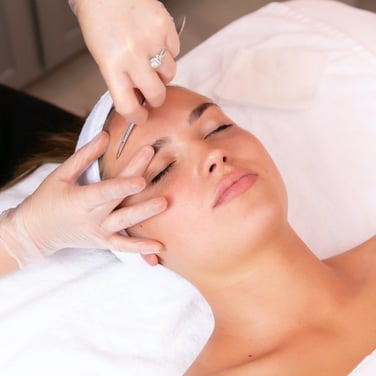Dermaplaning is a non-invasive cosmetic procedure that involves using a sterile surgical scalpel to gently exfoliate the top layer of dead skin cells and remove fine vellus hair (peach fuzz) from the face.
“Oilplaning and dermaplaning both get rid of surface skin impurities and vellus hairs that inhibit any serums or products from infiltrating the skin,” Nurse Practitioner Samantha, FNP, said. “By removing any dead skin cells and vellus hairs, it allows for a very bright and clean complexion and allows your topical products to be absorbed more effectively.”
According to Samantha, oilplaning is better suited for those with dry skin to prevent any drying. It incorporates a pre-treatment oil that facilitates a smoother blade movement, reducing resistance, irritation, and the risk of injury compared to traditional dermaplaning techniques.

Benefits
Studies have demonstrated that dermaplaning can lead to improved skin texture, increased skin hydration, and a reduction in hyperpigmentation and acne scarring [1,2]. As dermaplaning removes the superficial layer of skin, it triggers a healing response in the body, prompting the production of new collagen and elastin fibers. This leads to an improvement in skin texture, as the increased collagen and elastin help to plump the skin and reduce the appearance of fine lines and wrinkles.
As new, fresh skin cells are generated due to exfoliation, they can gradually replace the hyperpigmented areas, leading to a reduction in pigmentation irregularities. The stimulation of collagen production can also help support a more even distribution of melanin, the pigment responsible for skin color.
Since dermaplaning can temporarily remove fine facial hair that trap excess oil and contribute to a shiny complexion, it can help reduce the oiliness of the skin that typically contributes to acne.
What to expect
A sterile surgical scalpel to gently exfoliate the top layer of dead skin cells and remove fine vellus hair (peach fuzz) from the face. You might feel a scratching or stinging sensation on your skin, but dermaplaning is not considered painful.
The effects of dermaplaning can vary depending on individual skin characteristics and the specific concerns being addressed. However, many people notice immediate results following a dermaplaning treatment. The skin often appears smoother, brighter, and more radiant due to the removal of the outer layer of dead skin cells.
For optimal results, dermaplaning is typically recommended to be performed every 3 to 4 weeks. This timeframe allows the skin to fully regenerate and recover between sessions. However, the frequency of dermaplaning can be adjusted based on individual needs and the recommendations of your skincare professional. Some individuals may benefit from more frequent treatments, while others may find that less frequent sessions are sufficient.
No down time is needed, though it is crucial to follow a consistent skincare routine and protect the skin from sun exposure following dermaplaning to maintain the results and support skin health.
Considerations
It's worth noting that dermaplaning may not be suitable for individuals with certain skin conditions, such as active acne lesions, inflamed or irritated skin, open wounds, sunburns, or skin infections. Sun protection is crucial both before and after dermaplaning. The exfoliated skin may be more sensitive to sunlight, so it is recommended to avoid direct sun exposure immediately after the procedure and to use broad-spectrum sunscreen daily to protect the newly revealed skin.
Takeaways
- Dermaplaning effectively removes the outermost layer of dead skin cells, which can accumulate and contribute to a dull and uneven complexion.
- Oilplaning is specifically recommended for those with dry skin.
- Combined effects of exfoliation, collagen stimulation, and improved product absorption contribute to the increased skin texture observed with dermaplaning.
- Regular dermaplaning treatments can help promote a smoother and more refined complexion.
Questions? Call PIH at 609.512.1468 for more information.
References
[1] Ko, E. J., Kim, Y. J., & Lim, K. H. (2020). The efficacy and safety of non-ablative rejuvenation using an 1,550-nm Erbium-doped Fractional Laser combined with 5% Ammonium lactate emulsion: A randomized, double-blind, split-face study. Annals of Dermatology, 32(6), 483-491.
[2] Na, J. I. (2018). Novel Approaches to Facial Rejuvenation. Dermatology and Therapy, 8(3), 331-342.